Which dry closet is better: liquid or composting? What to buy: peat or chemical option
The dry closet is an excellent replacement for cesspools. Its purchase is justified in the absence of a sewer network, a local treatment plant or septic tank. The stand-alone unit is useful for long country trips or for caring for sick people.
Among a large assortment of devices, models of different operating principles are presented, differing in installation method, ease of use and price. To help determine which dry closet is better - peat, liquid or chemical, we will compare their characteristics and talk about the nuances of operation.
The content of the article:
General classification of dry closets
First of all, the options for existing autonomous sanitary systems should be identified.
All types of toilets independent of sewerage can be classified according to some criteria:
- a method of processing waste;
- installation method of autonomous plumbing;
- type of food plumbing device.
Most dry closets consist of two chambers. The upper block with a seat acts as a toilet bowl, the lower part - a tank for collecting and processing excrement.
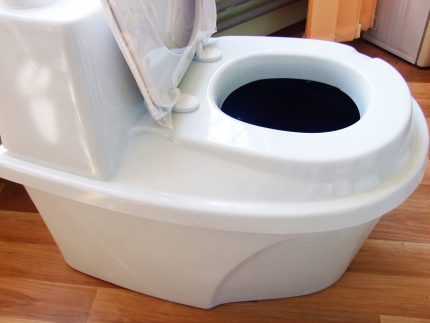
Based on the technology of waste disposal, modern dry closets can be divided into two categories:
- Liquid. Processing is carried out using special reagents that break down solid fractions. Depending on the fluid used, such toilets are divided into biological and chemical.
- Composting. Vital waste enters the storage tank, where it is dried with a compactor or mixed with peat.Obtained as a result of such processing, compost is buried in the ground or stored in a compost heap, in which it has to lie for another 2-3 years until it is completely “ripened”, after which it is permissible for them to fertilize the beds.
Composting dry closets are divided into two types: electric or peat. They radically differ from each other in the way they are processed.
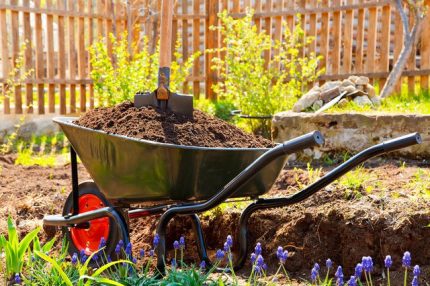
Based on the installation method, dry closets are divided into stationary and mobile models. The former involve securing a permanent place for the unit. As a rule, this requires the principle of the bio-nitase itself. For example, the arrangement of an exhaust ventilation duct, the connection of a drainage tube.
Stationary models include peat and electric sanitation systems.
Mobile modules are functional without connecting any communications. They have small dimensions, allowing you to carry them from place to place, take with you on a long trip, on a picnic, etc. Almost all liquid dry closets are portable.
According to the type of food, autonomous sanitary systems are divided into volatile and independent modules.

Liquid and peat dry closets work without electricity. They are perfect for operation in the field.
Features of the liquid devices
These models are in high demand due to mobility and affordable cost. They are convenient for caring for the elderly, sick people, for quick arrangement of the toilet in traveling conditions. However, for permanent use at home or in the country, it is better to choose another model - not requiring such frequent maintenance.
The principle of design and operation
Liquid dry closets are completely autonomous. Installation of a ventilation pipe, drain hose, or electrical connection is not required.
An autonomous bio-closet is designed very simply, there are two blocks in the design:
- Top knot. Designed as a toilet with a seat, a lid and a tank for chemical composition or liquid with active natural components. A flush pump is located here.
- Storage device. The lower compartment is a volumetric waste collection tank. Its displacement ranges from 12-25 liters.
In the housing of the storage tank can be placed a niche for storing reagents, a dividing rod and a pressure relief valve.
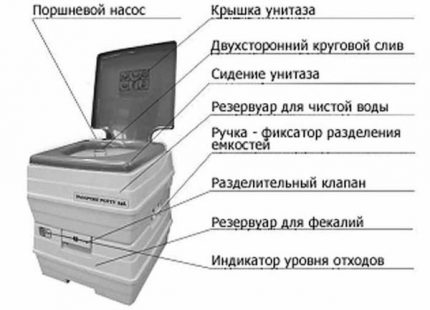
Both compartments are securely fastened together. The lower tank is additionally equipped with a seal that traps odors.
In the design of most models, an indicator is provided - a light beacon alerts the user when it is time to empty the storage tank. The indicator light changes color from green to red.
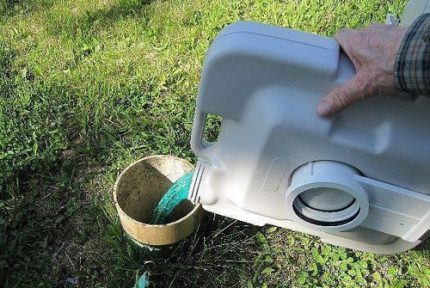
It is undesirable to throw ordinary toilet paper into the liquid dry closet - it does not decompose under the influence of cleavage compounds and leads to a quick filling of the tank.
Dry closet refills
To stimulate the decay of waste, chemicals or biological compounds are poured into the unit.
Features of various fillers:
- Chemical fluids. They quickly react and are able to process waste into a liquid mass in a day, completely neutralize the smell.The chemicals are aggressive, you need to empty the drive into the sewer or a separate hole away from the site so that the reagents do not harm the environment.
- Biostructures. Environmentally friendly drugs with a complex of microorganisms: bacteria and enzymes. They break down sewage to water and neutral components. Draining can be done directly into the ground - the processed mass will not cause harm to plants and animals.
Biological compounds convert sewage into fertilizers for a personal plot.
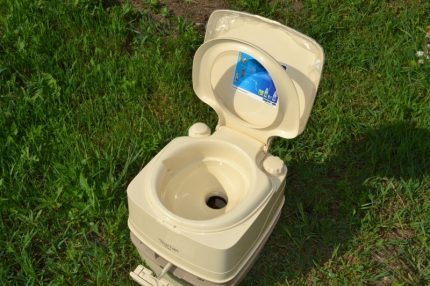
The only negative of biological fluids is the high cost.
Among the chemicals most often used:
- formalin-containing substances;
- nitrogen and ammonium compounds.
The first group of chemicals is considered very caustic and toxic. They quickly utilize waste, neutralize odor. However, their use is permissible only in city conditions - it is only necessary to remove formalin-containing liquid through the sewer network.

Estimated consumption of the drug is 1 liter for 4 months, about 8 gas stations.
Ammonium fluids are safer. However, the active components in contact with oxygen can quickly decompose - in 5-7 days. A significant plus is the ability to use recycled sewage for compost. Sewerage is not needed for their disposal, so such a dry closet can be used outside the city.
Pros and cons of liquid models
The strengths of all types of liquid dry closets include mobility, versatility of use, independence from communications, loyalty to pricing policy. In addition, the units are completely sealed and hygienic - they do not emit unpleasant odors.

The disadvantages of such dry closets:
- the need to purchase supplies;
- frequency cleaning the storage tank - a capacity of 20-25 liters is designed for 50 uses, provided that three people use it, they will have to empty the tank every week.
An additional minus of chemical bio-nitases is the toxicity of recycled waste.
Composting dry closets: operating nuances
Composting models - peat and electric are considered ecologically safe. Each type has its own characteristics of work and operation, strengths and weaknesses. General features: the need to install a ventilation pipe and drainage hose, the use of recycled waste as fertilizer.
Peat models - scheme of work
The entire sewage treatment cycle is based on natural processes. In the decomposition of waste peat with microorganisms plays an active role. Natural mineral serves as a kind of sponge, making the mass loose and uniform. Biobacteria break down solid waste, activate the composting process.
We also recommend reading an article on which filler to choose for a peat toilet. More details - go to the link.
The device of the peat aggregate is very simple. Some craftsmen make a prototype of a purchased dry closet using improvised means.
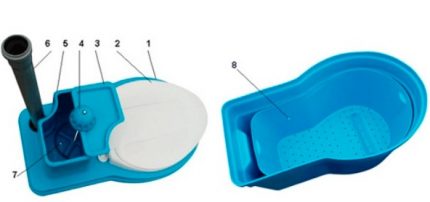
Peat models are considered stationary. It is desirable to install them in a compact ventilated room.To remove the unpleasant odor, it is necessary to connect a vertical ventilation duct.
Care should be taken to drain the liquid - a drainage hose is conducted from the storage tank to the ground, sewer or drainage pit. Part of the liquid sewage evaporates through ventilation.
Operating principle:
- After using the toilet, the dispenser knob is turned - peat is automatically poured into the waste compartment.
- Liquid is discharged into the soil through a tube.
- After filling the tank, the contents are poured into a compost pit. It is advisable that the fertilizer survive for another year.
The frequency of cleaning the container depends on its volume and the number of users. On average, a tank of 100 liters, subject to operation by a family of 4 people, will have to be emptied monthly.
The principle of action of electric bio-nitase
The device and technology for processing waste in an electric dry closet is somewhat more complicated. It provides for the separation of waste into liquid and solid fractions. The first - are discharged into a separate tank or drain hole through a drainage hose, the second - enter the lower tank.
The solid fractions are dried. This is due to active ventilation in the storage compartment.
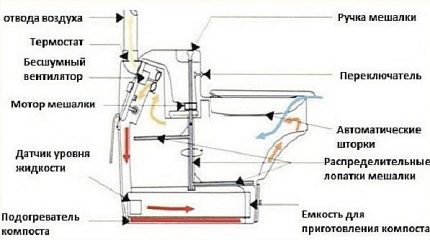
Gases and unpleasant odors are discharged through the ventilation pipe. Often, electric dry closets are equipped with forced draft.
Dried to a powder state, the waste goes to a separate receiver. After filling, clean. The frequency of service is 2-3 times per year.
Advantages and disadvantages of composting units
Despite the different processing technologies, peat and electric models have several common advantages.
The main advantages:
- environmental friendliness and safety;
- the possibility of using compost in crop production;
- reduction in the number of cleanings of the storage tank;
- year-round use in the country, in a private house.
Models have common flaws. Both types of dry closets are considered stationary, they require the connection of a ventilation duct, and the arrangement of drainage.
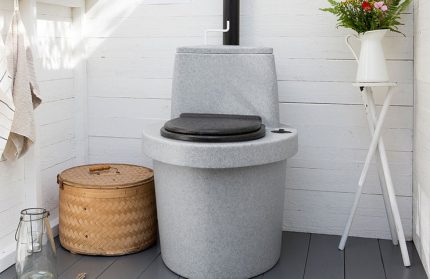
In addition to the general pros and cons, each device has its own specifics.
Distinctive features of peat dry closets:
- poor cleaning of the toilet - there is no water discharge;
- the need for peat composition - a dry filler with soil bacteria, aerobes, and chopped sawdust is suitable;
- effective ventilation of the room is required, otherwise unpleasant odors are noticeable;
- the difficulty of emptying the tank - drives are usually large, it is quite difficult to bring them to the compost pit and clean out;
- malfunctioning of the peat distribution mechanism - sometimes you have to add the dry mixture manually.
An important advantage of peat bogs is their affordable cost. These are the most popular models among summer residents.
Features of electrical sanitary systems:
- energy dependence - you cannot use the toilet without electricity;
- operation exclusively in a sitting position - with pressure on the seat, the curtain moves, tearing off the storage tank;
- very high price.
No flushing is needed in the electric toilet. After using the toilet, the waste container automatically closes.
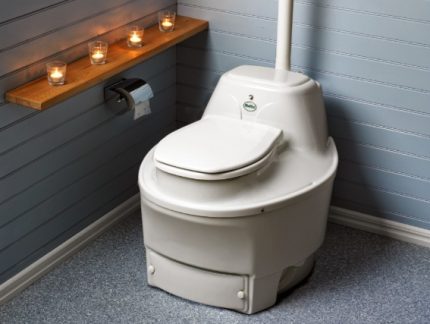
It is advisable to install such a unit in private houses or summer cottages of all-season residence, provided that there are no interruptions in the supply of electricity.
There is an article on our site which presents rating of dry closets for a summer cottage.
Comparison of the main parameters of different dry closets
To determine which toilet is best to buy - peat, liquid, chemical or electric, it is necessary to conduct a comparative analysis of the main parameters of choice.
Criteria for evaluation:
- Hygiene In this regard, superiority in electric and liquid models with water flushing. In peat toilets, manual filling of waste with a dry mixture is often required.
- Service. The leader is an electrical unit. The number of cleanings is minimal, there are no difficulties with emptying the tank. More often than others, a liquid toilet requires emptying, this option will not work for a large family.
- Mobility. There are no equal liquid models. They are chosen for travel, temporary use on vacation.
- Commissioning. The liquid closet is ready for use immediately after refueling the tanks with clean water and reagents. Composting devices require more time-consuming preparation.
- Environmental friendliness. All models except chemical toilets are environmentally friendly.
In terms of comfort, all dry closets are more or less equivalent - the height of the seat corresponds to the dimensions of a standard toilet. There is a nuance of using an electric moth - only a sitting position is permissible.
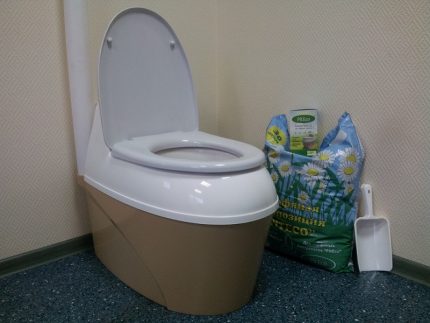
The cost of the electric option is several times higher than the competitors' price tags. But this dry closet does not require maintenance costs, except for the payment of electricity. In addition, electricity consumption is minimal and does not particularly affect the family budget.
It is not necessary to buy an expensive model of a dry closet for a summer cottage - you can build it yourself. And how to do this we examined in detail in this article.
Conclusions and useful video on the topic
Description of the principles of operation of peat and liquid dry closets. Comparison of models and selection tips:
Overview of different types of autonomous sanitary systems, rules of operation and maintenance:
You can’t say exactly which dry closet is better and which is worse. Various modifications will be the best solution in a given situation. If you need a portable toilet for periodic use, then a portable liquid device is suitable.
For a home or summer residence without autonomous sewage, it is better to buy a composting composting toilet. It does not have to be cleaned often, and recycled waste can be put into business and used to fertilize the beds.
What dry closet did you choose? What guided this? Are you satisfied with the purchased plumbing fixture? Please tell our readers about this. Leave your comments in the block for communication under the article.

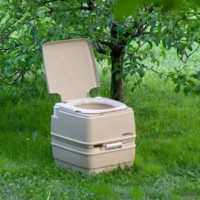 How to choose a dry closet for a summer residence: tips for choosing and an overview of the best models
How to choose a dry closet for a summer residence: tips for choosing and an overview of the best models  How to clean dry closets: features of cleaning peat and liquid varieties of dry closets
How to clean dry closets: features of cleaning peat and liquid varieties of dry closets 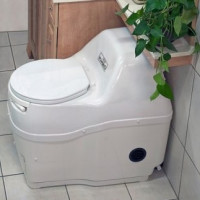 What is a dry closet: the principle of operation and the specifics of using autonomous plumbing
What is a dry closet: the principle of operation and the specifics of using autonomous plumbing 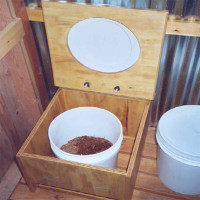 DIY dry closet: a step-by-step guide to the construction of a peat dry closet
DIY dry closet: a step-by-step guide to the construction of a peat dry closet 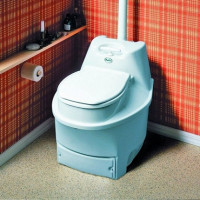 Rating of dry closets for a summer residence and a private house: popular models + recommendations for customers
Rating of dry closets for a summer residence and a private house: popular models + recommendations for customers  Sealant for sewer pipes: types, manufacturers overview, which are better and why
Sealant for sewer pipes: types, manufacturers overview, which are better and why  How much does it cost to connect gas to a private house: the price of organizing gas supply
How much does it cost to connect gas to a private house: the price of organizing gas supply  The best washing machines with dryer: model rating and customer tips
The best washing machines with dryer: model rating and customer tips  What is the color temperature of light and the nuances of choosing the temperature of the lamps to suit your needs
What is the color temperature of light and the nuances of choosing the temperature of the lamps to suit your needs  Replacement of a geyser in an apartment: replacement paperwork + basic norms and requirements
Replacement of a geyser in an apartment: replacement paperwork + basic norms and requirements
As for me, the dry closet is not much different from the toilet on the street. Our neighbors, for example, installed a tank in the summer toilet, covered it with a box of boards on top and installed a lid and a toilet seat. The contents of the tank are delivered weekly, as well as the compost composting toilet.For those who do not want to bother with arranging a summer toilet, it’s easier to buy a ready-made one, since it has no smells, but it needs care.
How is this no different? Firstly, this is a completely different level of comfort. Secondly, the technology of waste disposal here is not like the prehistoric dumping in the fetid unsanitary cesspool. Putting a toilet instead of a hole in the floor does not mean reaching the dry closet level.
We chose a liquid dry closet for our cottage. There is less trouble with it, water is drained, as in an ordinary toilet, only chemical reagents must be added to break down feces. But still, the dry closet does not compare with a stationary toilet, with which you do not have to fool. True, it is still better than a smelly street toilet, which is completely impossible to go to in the winter.